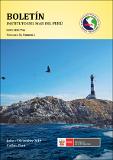Por favor, use este identificador para citar o enlazar este ítem:
https://hdl.handle.net/20.500.12958/3399| Título : | Dieta de la merluza peruana (Merluccius gayi peruanus Ginsburg, 1954) en otoño 2012 |
| Otros títulos : | Peruvian hake (Merluccius gayi peruanus Ginsburg, 1954) diet in autumn 2012 |
| Autor : | Castillo Cruz, David |
| Palabras clave : | Merluza Peruana;Alimentación |
| Fecha de publicación : | 2019 |
| Editorial : | Instituto del Mar del Perú |
| Citación : | Bol Inst Mar Perú. 34(2) 2019: p.355-368 |
| Citación : | Boletín IMARPE 34(2), 2019; |
| Resumen : | El crucero de evaluación de recursos demersales se realizó entre mayo y junio del
2012 a bordo del BIC José Olaya Balandra, su principal objetivo fue la evaluación del recurso merluza. Uno
de los aspectos biológicos evaluados fue ecología trófica. Se registraron 28 presas (8 crustáceos, 17 peces y
3 cefalópodos); destacaron por su importancia en aporte a la dieta: eufáusidos, múnida, el canibalismo y
anchoveta en todas las sub áreas y estratos; se calculó la ración diaria de 7,84 g/ind/día, con mayor aporte
del canibalismo. Se puede caracterizar a la merluza como un depredador carnívoro generalista, con cambios
ontogénicos respecto al tamaño de presas en función a la talla. El canibalismo se observó en ejemplares a
partir de los 20 cm de longitud total, ABSTRACT: Between May and June 2012, the demersal resources assessment cruise was carried out on board the R/V José Olaya Balandra, its main objective was the evaluation of the Peruvian hake resource. One of the biological aspects assessed was trophic ecology. A total of 28 prey were recorded (8 crustaceans, 17 fish, and 3 cephalopods); euphausiids, squat lobster, cannibalism, and anchoveta predominated in all subareas and strata for their importance in contributing to the diet; the daily ration of 7.84 g/ind/day was estimated, with a greater contribution from cannibalism. Peruvian hake can be characterized as a general carnivorous predator, with ontogenetic changes regarding prey size depending on length. Cannibalism was observed in specimens from 20 cm in total length, behavior that was increasing its importance as hake reached greater size. |
| URI : | https://hdl.handle.net/20.500.12958/3399 |
| ISSN : | 04587766 |
| Aparece en las colecciones: | Boletín 34(2), 2019 |
Ficheros en este ítem:
| Fichero | Descripción | Tamaño | Formato | |
|---|---|---|---|---|
| Boletin 34(2)-4.pdf | 1,44 MB | Adobe PDF |  Visualizar/Abrir |
Este ítem está sujeto a una licencia Creative Commons Licencia Creative Commons

